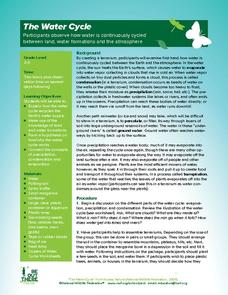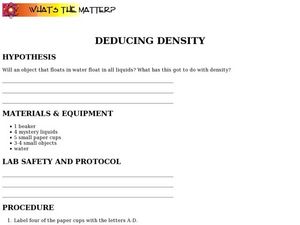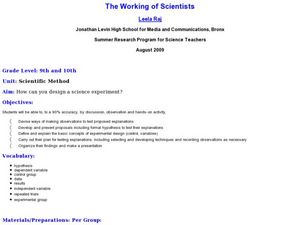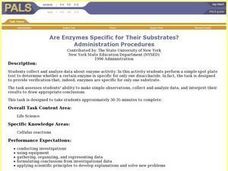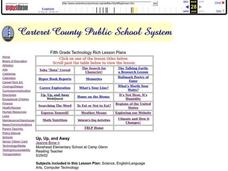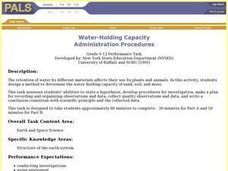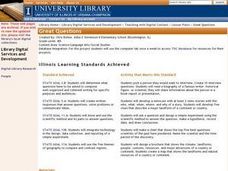Curated OER
Introduction to the Circulatory System
Fifth graders are introduced to the human circulatory system. After watching a Bill Nye video, they identify any misconceptions they had before watching it. They practice taking guided notes and discuss the video as a whole.
Curated OER
Introduction to the Circulatory System
Fifth graders analyze the components of the circulatory system. They take notes as they watch a video on blood and circulation. Students discuss the human circulatory system, including blood, veins, arteries, capillaries and the heart.
Curated OER
Teaching the Bell Tetrahedral Kite
Learners complete readings on kite making and kite flying. They analyze how the parts of a system interconnect and influence each other. Students identifies and uses color and form in a 3D artwork.
Curated OER
The Water Cycle
Students are introduced to the components and importance of the water cycle. They are shown how groundwater moves using a model. Students list 9 places on earth where water is found. They define the terms cycle and water cycle.
Curated OER
Heart Mobiles In Action
Students design a mobile or wall hanging that reviews the circulatory system. In this circulatory system lesson, students work in small groups to identify the structures of the heart, and create a model in the form of a two or three...
Curated OER
Observations and Inferences
Students observe how to distinguish observations form inferences. In this examining inferences lesson students list observations relating to the activity and discuss the importance of them.
Curated OER
Deducing Density
In this deducing density worksheet, students follow the procedures to set up an experiment about objects floating in water and liquids of different densities, answer questions, collect data and complete charts.
Curated OER
Fire Safety
Students discuss how to behave if there is a fire. In this fire prevention and awareness lesson, students review fire safety, review the procedures for leaving a house or building on fire and make rescue dogs.
Curated OER
Straw Rockets in Flight! Engineer's Delight
Sixth graders study air compression and how it can power a rocket. In this creative lesson students work with a partner and build a rocket then compare air compressions and graph their results.
Curated OER
The Working of Scientists
Students define and explain the basic concepts of experimental design. In this scientific method lesson students complete a hands on activity, develop and present proposals to test their explanations.
Curated OER
Famous Rock Groups
Students define igneous, metamorphic, and sedimentary, and use rock identification books to identify igneous, metamorphic, and sedimentary rocks. Students then discuss which rocks early man would have found useful for tool creation.
Curated OER
Let the Sunshine in
Students collect and analyze data to study wavelengths of visible light. They cover Styrofoam cups with three different colors of sun filtering products and shine a lamp directly on the cups. They determine the most effective filtering...
Curated OER
Are Enzymes Specific for Their Substrates?
Students discover enzyme to substrate specificity. The experiment uses samples of glucose and lactose in combination with the enzyme lactase. Students observe the reaction between the lactose and the lactase; the lack of a reaction...
Curated OER
Up, Up, and Away
Fifth graders participate in a WebQuest that introduces them to a study on clouds and how they relate to weather systems.
Curated OER
Sound All Around Us
Students make predictions about how sound is formed. They view and discuss a video that explores sound formation and attempt to identify the origin of different sounds.
Curated OER
Ph-ocusing on Photosynthesis In and Out of the Garden
Students are introduced to the concept of photosynthesis. As a class, they brainstorm a list of what they already know about plants and individually grow a plant on their own in the classroom. They record their observations daily and...
Curated OER
Testing Battery Combinations
Fourth graders examine the required combinations of plates and predict which combination will generate the most and least current and voltage. They use an ammeter and experiment with combinations of their own testing and record each...
Curated OER
Water-Holding Capacity
Students design and conduct an experiment to compare the water-holding capacity of sand, soil, and moss. They measure the change in weight for each material after adding the same amount of water to each material.
Curated OER
Take A Meal Worm To Lunch
Seventh graders, using a magnifying glass, observe mealworms in a cup.
Alabama Learning Exchange
Teaching the Scientific Method
Eighth graders watch a PowerPoint presentation that focuses on the scientific method including developing a hypothesis. They examine how to perform a scientific experiment using a method that maintains its validity, collect and use the...
Curated OER
Breaking Color Barriers
Students compare brown eggs and white eggs. In this color lesson, students see two different color eggs and predict what they will look like on the inside. They see that both eggs are the same and compare this to people of different...
Curated OER
A Model of Earth's Tectonic Plates
High schoolers build a model of the Earth showing tectonic plate boundaries. The pattern for the model is provided in the lesson. This is a very useful hands-on component for a lesson about geology or earthquakes.
Curated OER
Great Questions
Fourth graders research and create questions about a famous person. They create questions in a game format, create a computer generated brochure, and develop rubrics for their finished projects.



